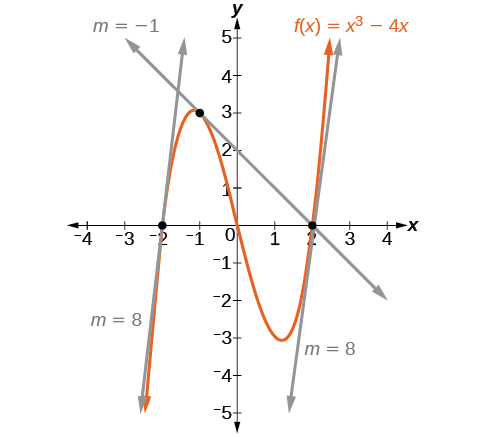
In this section, you will:
The average teen in the United States opens a refrigerator door an estimated 25 times per day. Supposedly, this average is up from 10 years ago when the average teenager opened a refrigerator door 20 times per day 1.
It is estimated that a television is on in a home 6.75 hours per day, whereas parents spend an estimated 5.5 minutes per day having a meaningful conversation with their children. These averages, too, are not the same as they were 10 years ago, when the television was on an estimated 6 hours per day in the typical household, and parents spent 12 minutes per day in meaningful conversation with their kids.
What do these scenarios have in common? The functions representing them have changed over time. In this section, we will consider methods of computing such changes over time.
The functions describing the examples above involve a change over time. Change divided by time is one example of a rate. The rates of change in the previous examples are each different. In other words, some changed faster than others. If we were to graph the functions, we could compare the rates by determining the slopes of the graphs.
A tangent line to a curve is a line that intersects the curve at only a single point but does not cross it there. (The tangent line may intersect the curve at another point away from the point of interest.) If we zoom in on a curve at that point, the curve appears linear, and the slope of the curve at that point is close to the slope of the tangent line at that point.
[link] represents the function
We can see the slope at various points along the curve.
is 8
is –1
is 8

Let’s imagine a point on the curve of function
at
as shown in [link]. The coordinates of the point are
Connect this point with a second point on the curve a little to the right of
with an x-value increased by some small real number
The coordinates of this second point are
for some positive-value
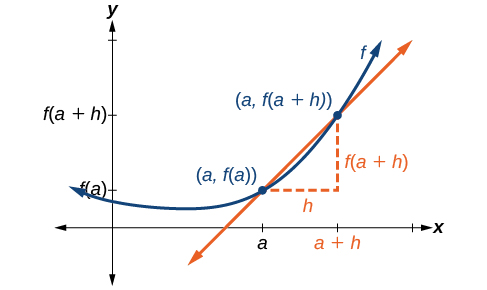
We can calculate the slope of the line connecting the two points
and
called a secant line, by applying the slope formula,
We use the notation
to represent the slope of the secant line connecting two points.
The slope
equals the average rate of change between two points
and
The average rate of change (AROC) between two points
and
on the curve of
is the slope of the line connecting the two points and is given by
Find the average rate of change connecting the points
and
We know the average rate of change connecting two points may be given by
If one point is
or
then
The value
is the displacement from
to
which equals
For the other point,
is the y-coordinate at
which is
or
so
Find the average rate of change connecting the points
and
3
Now that we can find the average rate of change, suppose we make
in [link] smaller and smaller. Then
will approach
as
gets smaller, getting closer and closer to 0. Likewise, the second point
will approach the first point,
As a consequence, the connecting line between the two points, called the secant line, will get closer and closer to being a tangent to the function at
and the slope of the secant line will get closer and closer to the slope of the tangent at
See [link].
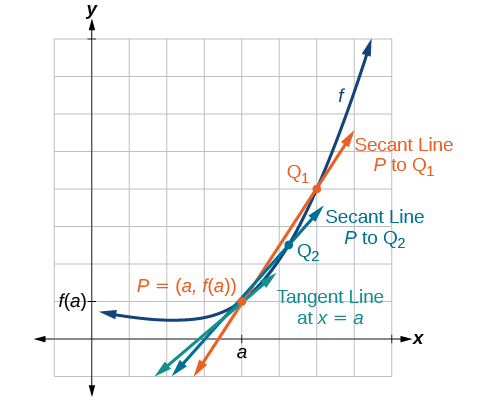
Because we are looking for the slope of the tangent at
we can think of the measure of the slope of the curve of a function
at a given point as the rate of change at a particular instant. We call this slope the instantaneous rate of change, or the derivative of the function at
Both can be found by finding the limit of the slope of a line connecting the point at
with a second point infinitesimally close along the curve. For a function
both the instantaneous rate of change of the function and the derivative of the function at
are written as
and we can define them as a two-sided limit that has the same value whether approached from the left or the right.
The expression by which the limit is found is known as the difference quotient.
The derivative, or instantaneous rate of change, of a function
at
is given by
The expression
is called the difference quotient.
We use the difference quotient to evaluate the limit of the rate of change of the function as
approaches 0.
The derivative of a function can be interpreted in different ways. It can be observed as the behavior of a graph of the function or calculated as a numerical rate of change of the function.
at a point
is the slope of the tangent line to the curve
at
The derivative of
at
is written
measures how the curve changes at the point
may be thought of as the instantaneous rate of change of the function
at
The equation of the derivative of a function
is written as
where
The notation
is read as “
” Alternate notations for the derivative include the following:
The expression
is now a function of
; this function gives the slope of the curve
at any value of
The derivative of a function
at a point
is denoted
**Given a function
find the derivative by applying the definition of the derivative.**
Find the derivative of the function
at
We have:
Substitute
and
Find the derivative of the function
at
To find the derivative of a rational function, we will sometimes simplify the expression using algebraic techniques we have already learned.
Find the derivative of the function
at
Find the derivative of the function
at
To find derivatives of functions with roots, we use the methods we have learned to find limits of functions with roots, including multiplying by a conjugate.
Find the derivative of the function
at
We have
Multiply the numerator and denominator by the conjugate:
Find the derivative of the function
at
Many applications of the derivative involve determining the rate of change at a given instant of a function with the independent variable time—which is why the term instantaneous is used. Consider the height of a ball tossed upward with an initial velocity of 64 feet per second, given by
where
is measured in seconds and
is measured in feet. We know the path is that of a parabola. The derivative will tell us how the height is changing at any given point in time. The height of the ball is shown in [link] as a function of time. In physics, we call this the “s-t graph.”
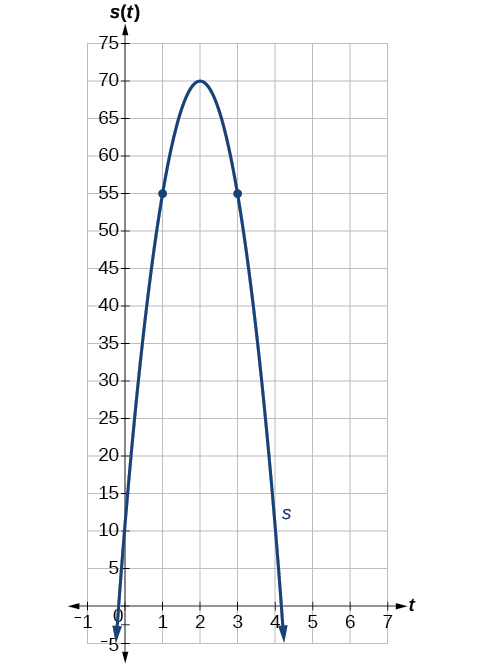
Using the function above,
what is the instantaneous velocity of the ball at 1 second and 3 seconds into its flight?
The velocity at
and
is the instantaneous rate of change of distance per time, or velocity. Notice that the initial height is 6 feet. To find the instantaneous velocity, we find the derivative and evaluate it at
and
For any value of
,
tells us the velocity at that value of
Evaluate
and
The velocity of the ball after 1 second is 32 feet per second, as it is on the way up.
The velocity of the ball after 3 seconds is
feet per second, as it is on the way down.
The position of the ball is given by
What is its velocity 2 seconds into flight?
0
We can estimate an instantaneous rate of change at
by observing the slope of the curve of the function
at
We do this by drawing a line tangent to the function at
and finding its slope.
Given a graph of a functionfind the instantaneous rate of change of the function at
on the graph of the function
at
and at no other point in that section of the curve. Extend the line far enough to calculate its slope as
From the graph of the function
presented in [link], estimate each of the following:
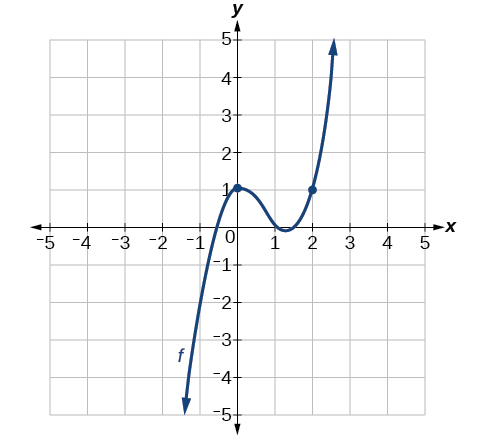
To find the functional value,
find the y-coordinate at
To find the derivative at
draw a tangent line at
and estimate the slope of that tangent line. See [link].
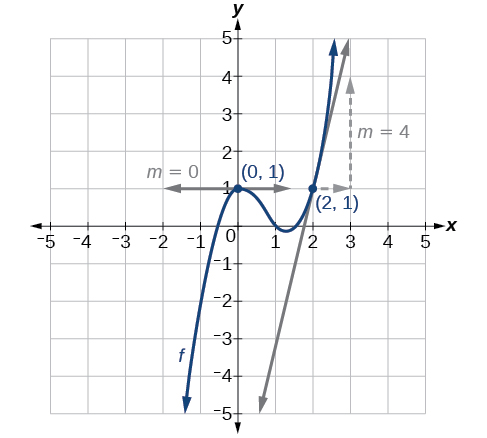
is the y-coordinate at
The point has coordinates
thus
is the y-coordinate at
The point has coordinates
thus
is found by estimating the slope of the tangent line to the curve at
The tangent line to the curve at
appears horizontal. Horizontal lines have a slope of 0, thus
is found by estimating the slope of the tangent line to the curve at
Observe the path of the tangent line to the curve at
As the
value moves one unit to the right, the
value moves up four units to another point on the line. Thus, the slope is 4, so
0, 0,
Another way to interpret an instantaneous rate of change at
is to observe the function in a real-world context. The unit for the derivative of a function
is
Such a unit shows by how many units the output changes for each one-unit change of input. The instantaneous rate of change at a given instant shows the same thing: the units of change of output per one-unit change of input.
One example of an instantaneous rate of change is a marginal cost. For example, suppose the production cost for a company to produce
items is given by
in thousands of dollars. The derivative function tells us how the cost is changing for any value of
in the domain of the function. In other words,
is interpreted as a marginal cost, the additional cost in thousands of dollars of producing one more item when
items have been produced. For example,
is the approximate additional cost in thousands of dollars of producing the 12th item after 11 items have been produced.
means that when 11 items have been produced, producing the 12th item would increase the total cost by approximately $2,500.00.
The cost in dollars of producing
laptop computers in dollars is
At the point where 200 computers have been produced, what is the approximate cost of producing the 201st unit?
If
describes the cost of producing
computers,
will describe the marginal cost. We need to find the derivative. For purposes of calculating the derivative, we can use the following functions:
The marginal cost of producing the 201st unit will be approximately $300.
A car leaves an intersection. The distance it travels in miles is given by the function
where
represents hours. Explain the following notations:
First we need to evaluate the function
and the derivative of the function
and distinguish between the two. When we evaluate the function
we are finding the distance the car has traveled in
hours. When we evaluate the derivative
we are finding the speed of the car after
hours.
means that in zero hours, the car has traveled zero miles.
means that one hour into the trip, the car is traveling 60 miles per hour.
means that one hour into the trip, the car has traveled 70 miles. At some point during the first hour, then, the car must have been traveling faster than it was at the 1-hour mark.
means that two hours and thirty minutes into the trip, the car has traveled 150 miles.
A runner runs along a straight east-west road. The function
gives how many feet eastward of her starting point she is after
seconds. Interpret each of the following as it relates to the runner.
To understand where a function’s derivative does not exist, we need to recall what normally happens when a function
has a derivative at
. Suppose we use a graphing utility to zoom in on
. If the function
is differentiable, that is, if it is a function that can be differentiated, then the closer one zooms in, the more closely the graph approaches a straight line. This characteristic is called linearity.
Look at the graph in [link]. The closer we zoom in on the point, the more linear the curve appears.
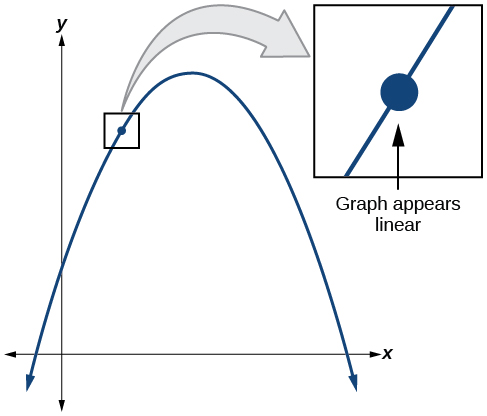
We might presume the same thing would happen with any continuous function, but that is not so. The function
for example, is continuous at
but not differentiable at
As we zoom in close to 0 in [link], the graph does not approach a straight line. No matter how close we zoom in, the graph maintains its sharp corner.
| = | x | , with x-axis from –0.1 to 0.1 and y-axis from –0.1 to 0.1.”){: #CNX_Precalc_Figure_12_04_009} |
We zoom in closer by narrowing the range to produce [link] and continue to observe the same shape. This graph does not appear linear at
| = | x | , with x-axis from –0.001 to 0.001 and y-axis from—0.001 to 0.001.”){: #CNX_Precalc_Figure_12_04_010} |
What are the characteristics of a graph that is not differentiable at a point? Here are some examples in which function
is not differentiable at
In [link], we see the graph of
Notice that, as
approaches 2 from the left, the left-hand limit may be observed to be 4, while as
approaches 2 from the right, the right-hand limit may be observed to be 6. We see that it has a discontinuity at
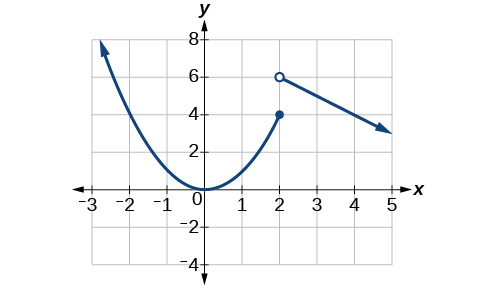
In [link], we see the graph of
We see that the graph has a corner point at
| = | x | has a corner point at x=0 .”){: #CNX_Precalc_Figure_12_04_012} |
In [link], we see that the graph of
has a cusp at
A cusp has a unique feature. Moving away from the cusp, both the left-hand and right-hand limits approach either infinity or negative infinity. Notice the tangent lines as
approaches 0 from both the left and the right appear to get increasingly steeper, but one has a negative slope, the other has a positive slope.
![The graph of
f(x)=
x
2
3
has a cusp at
x=0.
Graph of f(x) = x^(2/3) with a viewing window of [-3, 3] by [-2, 3].](../resources/CNX_Precalc_Figure_12_04_013.jpg)
In [link], we see that the graph of
has a vertical tangent at
Recall that vertical tangents are vertical lines, so where a vertical tangent exists, the slope of the line is undefined. This is why the derivative, which measures the slope, does not exist there.
![The graph of
f(x)=
x
1
3
has a vertical tangent at
x=0.
Graph of f(x) = x^(1/3) with a viewing window of [-3, 3] by [-3, 3].](../resources/CNX_Precalc_Figure_12_04_014.jpg)
A function
is differentiable at
if the derivative exists at
which means that
exists.
There are four cases for which a function
is not differentiable at a point
Using [link], determine where the function is
At the points where the graph is discontinuous or not differentiable, state why.
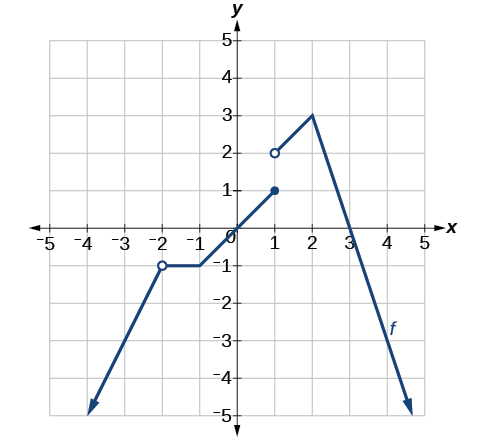
The graph of
is continuous on
The graph of
has a removable discontinuity at
and a jump discontinuity at
See [link].
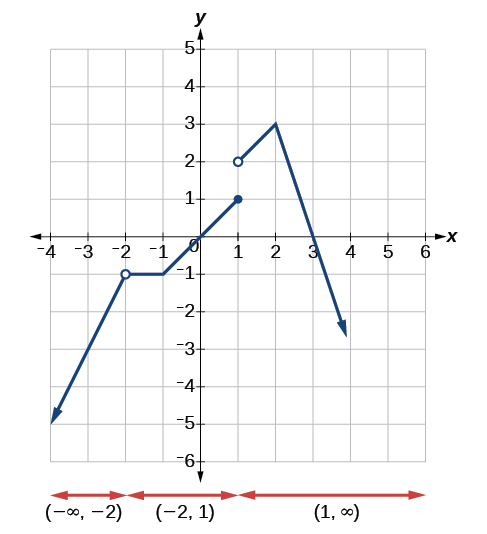
The graph of is differentiable on
The graph of
is not differentiable at
because it is a point of discontinuity, at
because of a sharp corner, at
because it is a point of discontinuity, and at
because of a sharp corner. See [link].
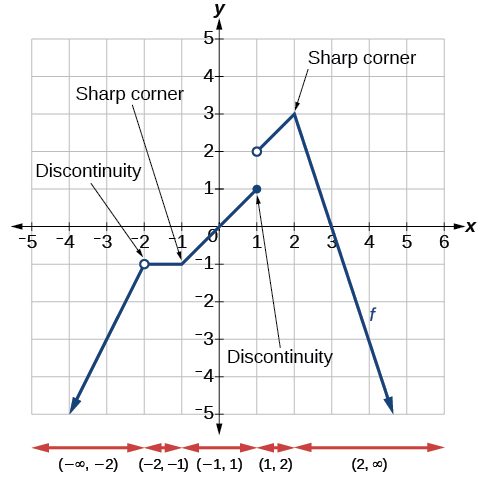
The graph of
is continuous on
The graph of
is discontinuous at
and
The graph of
is differentiable on
The graph of
is not differentiable at
and
The equation of a tangent line to a curve of the function
at
is derived from the point-slope form of a line,
The slope of the line is the slope of the curve at
and is therefore equal to
the derivative of
at
The coordinate pair of the point on the line at
is
If we substitute into the point-slope form, we have
 The equation of the tangent line is
The equation of the tangent line is
The equation of a line tangent to the curve of a function
at a point
is
Given a functionfind the equation of a line tangent to the function at
at
using
This is
and
into
Find the equation of a line tangent to the curve
at
Using:
Substitute
and
Equation of tangent line at
We can use a graphing utility to graph the function and the tangent line. In so doing, we can observe the point of tangency at
as shown in [link].
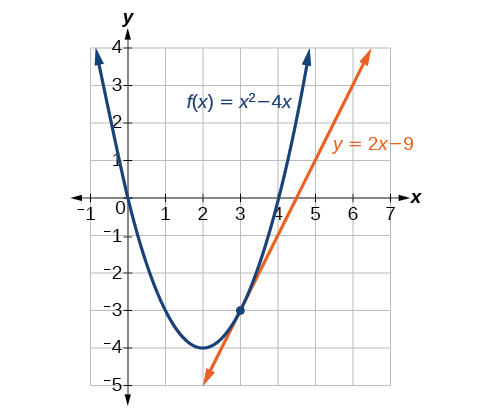
Find the equation of a tangent line to the curve of the function
at
If a function measures position versus time, the derivative measures displacement versus time, or the speed of the object. A change in speed or direction relative to a change in time is known as velocity. The velocity at a given instant is known as instantaneous velocity.
In trying to find the speed or velocity of an object at a given instant, we seem to encounter a contradiction. We normally define speed as the distance traveled divided by the elapsed time. But in an instant, no distance is traveled, and no time elapses. How will we divide zero by zero? The use of a derivative solves this problem. A derivative allows us to say that even while the object’s velocity is constantly changing, it has a certain velocity at a given instant. That means that if the object traveled at that exact velocity for a unit of time, it would travel the specified distance.
Let the function
represent the position of an object at time
The instantaneous velocity or velocity of the object at time
is given by
A ball is tossed upward from a height of 200 feet with an initial velocity of 36 ft/sec. If the height of the ball in feet after
seconds is given by
find the instantaneous velocity of the ball at
First, we must find the derivative
. Then we evaluate the derivative at
using
and
This result means that at time
seconds, the ball is dropping at a rate of 28 ft/sec.
A fireworks rocket is shot upward out of a pit 12 ft below the ground at a velocity of 60 ft/sec. Its height in feet after
seconds is given by
What is its instantaneous velocity after 4 seconds?
–68 ft/sec, it is dropping back to Earth at a rate of 68 ft/s.
Access these online resources for additional instruction and practice with derivatives.
Visit this website for additional practice questions from Learningpod.
| average rate of change |
| derivative of a function |
How is the slope of a linear function similar to the derivative?
The slope of a linear function stays the same. The derivative of a general function varies according to
Both the slope of a line and the derivative at a point measure the rate of change of the function.
What is the difference between the average rate of change of a function on the interval
and the derivative of the function at
A car traveled 110 miles during the time period from 2:00 P.M. to 4:00 P.M. What was the car’s average velocity? At exactly 2:30 P.M., the speed of the car registered exactly 62 miles per hour. What is another name for the speed of the car at 2:30 P.M.? Why does this speed differ from the average velocity?
Average velocity is 55 miles per hour. The instantaneous velocity at 2:30 p.m. is 62 miles per hour. The instantaneous velocity measures the velocity of the car at an instant of time whereas the average velocity gives the velocity of the car over an interval.
Explain the concept of the slope of a curve at point
Suppose water is flowing into a tank at an average rate of 45 gallons per minute. Translate this statement into the language of mathematics.
The average rate of change of the amount of water in the tank is 45 gallons per minute. If
is the function giving the amount of water in the tank at any time
then the average rate of change of
between
and
is
For the following exercises, use the definition of derivative
to calculate the derivative of each function.
For the following exercises, find the average rate of change between the two points.
and
and
and
and
undefined
For the following polynomial functions, find the derivatives.
For the following functions, find the equation of the tangent line to the curve at the given point
on the curve.
For the following exercise, find
such that the given line is tangent to the graph of the function.
or
For the following exercises, consider the graph of the function
and determine where the function is continuous/discontinuous and differentiable/not differentiable.
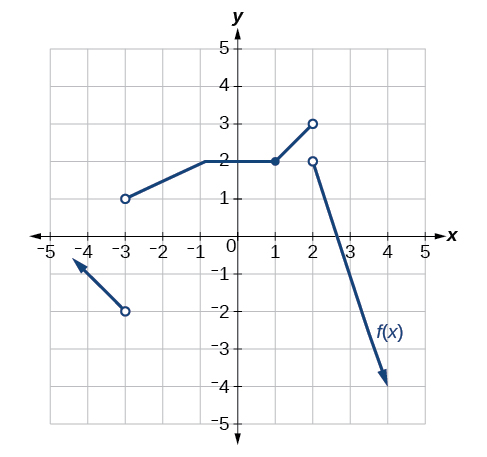
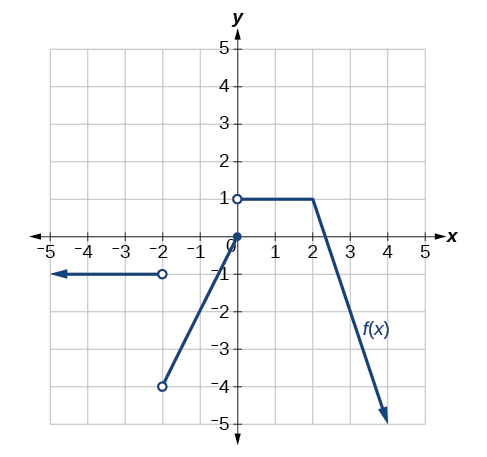
Discontinuous at
and
Not differentiable at –2, 0, 2.
Discontinuous at
Not differentiable at -4, –2, 0, 1, 3, 4, 5.
For the following exercises, use [link] to estimate either the function at a given value of
or the derivative at a given value of
as indicated.
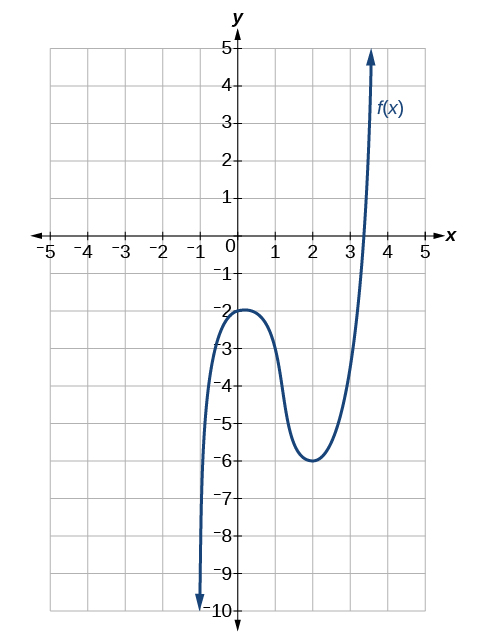
Sketch the function based on the information below:
,
Numerically evaluate the derivative. Explore the behavior of the graph of
around
by graphing the function on the following domains:
,
,
and
. We can use the feature on our calculator that automatically sets Ymin and Ymax to the Xmin and Xmax values we preset. (On some of the commonly used graphing calculators, this feature may be called ZOOM FIT or ZOOM AUTO). By examining the corresponding range values for this viewing window, approximate how the curve changes at
that is, approximate the derivative at
Answers vary. The slope of the tangent line near
is 2.
For the following exercises, explain the notation in words. The volume
of a tank of gasoline, in gallons,
minutes after noon.
At 12:30 p.m., the rate of change of the number of gallons in the tank is –20 gallons per minute. That is, the tank is losing 20 gallons per minute.
At 200 minutes after noon, the volume of gallons in the tank is changing at the rate of 30 gallons per minute.
For the following exercises, explain the functions in words. The height,
of a projectile after
seconds is given by
The height of the projectile after 2 seconds is 96 feet.
The height of the projectile at
seconds is 96 feet.
The height of the projectile is zero at
and again at
In other words, the projectile starts on the ground and falls to earth again after 5 seconds.
For the following exercises, the volume
of a sphere with respect to its radius
is given by
Find the average rate of change of
as
changes from 1 cm to 2 cm.
Find the instantaneous rate of change of
when
For the following exercises, the revenue generated by selling
items is given by
Find the average change of the revenue function as
changes from
to
Find
and interpret.
$50.00 per unit, which is the instantaneous rate of change of revenue when exactly 10 units are sold.
Find
and interpret. Compare
to
and explain the difference.
For the following exercises, the cost of producing
cellphones is described by the function
Find the average rate of change in the total cost as
changes from
$21 per unit
Find the approximate marginal cost, when 15 cellphones have been produced, of producing the 16th cellphone.
Find the approximate marginal cost, when 20 cellphones have been produced, of producing the 21st cellphone.
$36
For the following exercises, use the definition for the derivative at a point
to find the derivative of the functions.
For the following exercises, use [link].
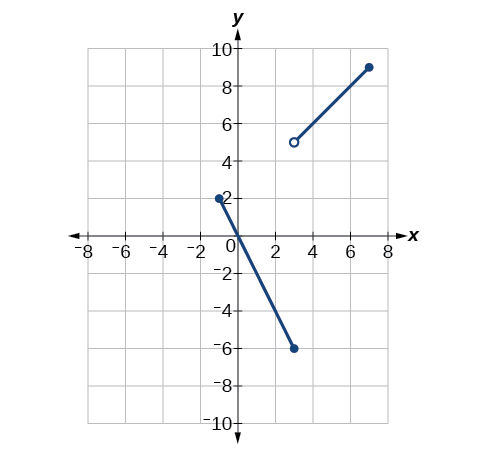
2
does not exist
At what values of
is the function discontinuous? What condition of continuity is violated?
Using [link], estimate
| −0.1 | 2.875 |
| −0.01 | 2.92 |
| −0.001 | 2.998 |
| 0 | Undefined |
| 0.001 | 2.9987 |
| 0.01 | 2.865 |
| 0.1 | 2.78145 |
| 0.15 | 2.678 |
3
For the following exercises, with the use of a graphing utility, use numerical or graphical evidence to determine the left- and right-hand limits of the function given as
approaches
If the function has limit as
approaches
state it. If not, discuss why there is no limit.
For the following exercises, find the limits if
and
2
3
For the following exercises, evaluate the limits using algebraic techniques.
12
For the following exercises, use numerical evidence to determine whether the limit exists at
If not, describe the behavior of the graph of the function at
At
the function has a vertical asymptote.
removable discontinuity at
For the following exercises, determine where the given function
is continuous. Where it is not continuous, state which conditions fail, and classify any discontinuities.
continuous on
removable discontinuity at
is not defined, but limits exist.
discontinuity at
and
Both
and
are not defined.
removable discontinuity at
is not defined.
For the following exercises, find the average rate of change
0
For the following exercises, find the derivative of the function.
Find the equation of the tangent line to the graph of
at the indicated
value. * * *
;
For the following exercises, with the aid of a graphing utility, explain why the function is not differentiable everywhere on its domain. Specify the points where the function is not differentiable.
Given that the volume of a right circular cone is
and that a given cone has a fixed height of 9 cm and variable radius length, find the instantaneous rate of change of volume with respect to radius length when the radius is 2 cm. Give an exact answer in terms of
For the following exercises, use the graph of
in [link].
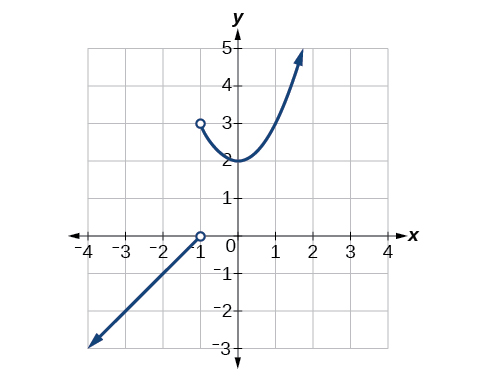
3
0
At what values of
is
discontinuous? What property of continuity is violated?
For the following exercises, with the use of a graphing utility, use numerical or graphical evidence to determine the left- and right-hand limits of the function given as
approaches
If the function has a limit as
approaches
state it. If not, discuss why there is no limit
and
Thus, the limit of the function as
approaches 2 does not exist.
For the following exercises, evaluate each limit using algebraic techniques.
1
For the following exercises, determine whether or not the given function
is continuous. If it is continuous, show why. If it is not continuous, state which conditions fail.
removable discontinuity at
For the following exercises, use the definition of a derivative to find the derivative of the given function at
For the graph in [link], determine where the function is continuous/discontinuous and differentiable/not differentiable.
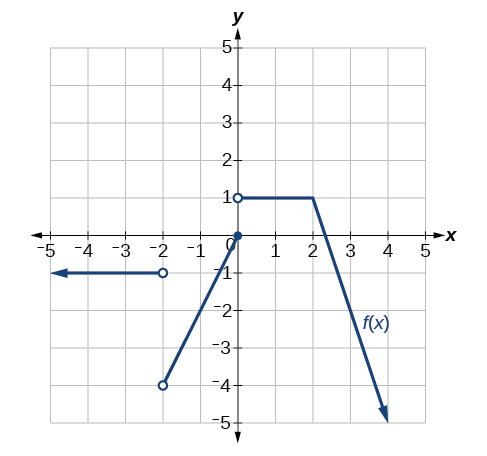
discontinuous at –2,0, not differentiable at –2,0, 2.
For the following exercises, with the aid of a graphing utility, explain why the function is not differentiable everywhere on its domain. Specify the points where the function is not differentiable.
not differentiable at
(no limit)
For the following exercises, explain the notation in words when the height of a projectile in feet,
is a function of time
in seconds after launch and is given by the function
the height of the projectile at
seconds
the average velocity from
For the following exercises, use technology to evaluate the limit.
0
Evaluate the limit by hand.
At what value(s) of
is the function below discontinuous?
For the following exercises, consider the function whose graph appears in [link].
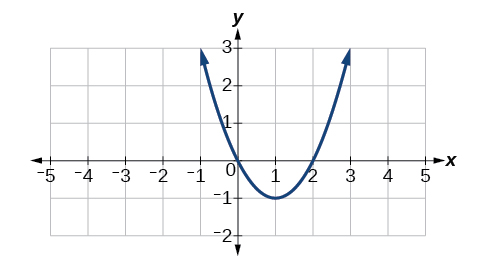
Find the average rate of change of the function from
2
Find all values of
at which
Find all values of
at which
does not exist.
Find an equation of the tangent line to the graph of
the indicated point:
For the following exercises, use the function
.
Graph the function
by entering
and then by entering
.
Explore the behavior of the graph of
around
by graphing the function on the following domains, [0.9, 1.1], [0.99, 1.01], [0.999, 1.001], and [0.9999, 1.0001]. Use this information to determine whether the function appears to be differentiable at
The graph is not differentiable at
(cusp).
For the following exercises, find the derivative of each of the functions using the definition:
and
on the curve of
it is given by
at a point
it is
providing the limit exists.
for which the derivative exists at
In other words, if
exists.
it is given by
represents the position of an object at time
and the instantaneous velocity or velocity of the object at time
is given by

You can also download for free at http://cnx.org/contents/fd53eae1-fa23-47c7-bb1b-972349835c3c@8.1
Attribution: